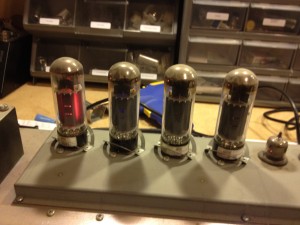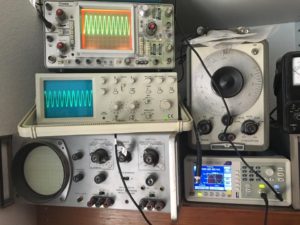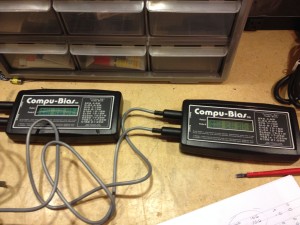BIAS ADJUSTMENT
TONE & TUBE LIFE
I cannot stress the importance of a proper bias enough. Without a proper bias, the amplifier is never going to function at its best. Power tubes play a very important roll in the perception of headroom and dimension, as well as the noise floor of the amplifier. Preamp tubes are equally as important. However, if your power tubes are biased cold, the amplifier is only putting out a fraction of the wattage the tube is capable of. The tone is cold, dark, overly clean in a non-dimensional way, lacking warmth and note bloom. Oftentimes fixed bias amplifiers are shipped with a cold bias to allow for a one-size-fits-all approach during assembly. If you are lucky, your amp got a hot set of output tubes so it’s closer to the true bias point — otherwise a perfectly great amplifier could sound horrible for no other reason than poor bias. If tone isn’t enough, improper bias can cause premature tube failure resulting in potential damage to the output transformer.

Luckily, fixed bias amplifiers can be modified to an adjustable fixed bias (see Modifications). This allows the fixed bias value to be dialed in precisely to the correct bias point for the set of tubes being used. The added benefit of a fixed bias modification is that you are no longer handcuffed by a manufacturer that forces you to purchase replacement tubes directly from them, allowing you to save money on aftermarket tubes (in many cases the exact same tubes without a premium markup price). If the amplifier is biased too hot, two things can happen: The first is a reaction referred to as “red plating”, where the plates are over-biased (too much current), stripping the tube of its ability to conduct. This is sure death for a consumer amplifier tube (not taking into account industrial tubes that use the glowing plate as an additional getter). Tube life can often be measured in moments, minutes, hours, days, and death. The second thing that can happen is saturation or early breakup — an overdriven and mushy note response. The ideal bias should give you the benefit of prolonged tube life, with the right balance of note sustain, headroom, and note bloom, while achieving a balanced dimensional character to the playing. Within every bias range is a small percentage of subjective tonal characteristic.
Desert Amplifier Repair uses a specially developed biasing method blending static and dynamic bias styles to create the perfect balance between tone and tube life, giving every amplifier DAR biases incredible headroom and dynamics. Unlike using a simple voltmeter and bias probe to reach a predetermined one-size-fits-all number someone got off the internet, DAR calculates the ideal bias point based on your amplifier’s voltages and tube strength.
 Before the biasing procedure is started, the original bias measurements the amplifier came in with are documented. DAR first tests every tube on our Amplitrex AT1000 for matching, characteristics, microphonics, gas, and leakage. Once the tubes are determined to be within matched tolerances and free of issues, the tubes are then installed and allowed to heat up for 5 minutes. Using a set of Compubias bias meters to monitor the bias for each tube in real time, the tubes are then set to a safe operating bias and allowed to stretch and settle in. After that, the tubes are run through a cycle of different bias points over the next 10 minutes to aid in stabilizing the tubes before settling in on the target bias point. Once the tubes have been allowed to stabilize statically, a signal is applied to the amplifier and fine-tuned dynamically using an oscilloscope and tone generator. The final step of the biasing is to actually play the amplifier to dial in the final voicing by ear. After this is done, the amplifier remains on the test bench and is monitored for drift for another 10-20 minutes. At this point, if the measurements and tubes are stable, the final readings are documented and the biasing is complete.
Before the biasing procedure is started, the original bias measurements the amplifier came in with are documented. DAR first tests every tube on our Amplitrex AT1000 for matching, characteristics, microphonics, gas, and leakage. Once the tubes are determined to be within matched tolerances and free of issues, the tubes are then installed and allowed to heat up for 5 minutes. Using a set of Compubias bias meters to monitor the bias for each tube in real time, the tubes are then set to a safe operating bias and allowed to stretch and settle in. After that, the tubes are run through a cycle of different bias points over the next 10 minutes to aid in stabilizing the tubes before settling in on the target bias point. Once the tubes have been allowed to stabilize statically, a signal is applied to the amplifier and fine-tuned dynamically using an oscilloscope and tone generator. The final step of the biasing is to actually play the amplifier to dial in the final voicing by ear. After this is done, the amplifier remains on the test bench and is monitored for drift for another 10-20 minutes. At this point, if the measurements and tubes are stable, the final readings are documented and the biasing is complete.

During normal operation of your amplifier, the tubes will age and begin to drift. This is often most noticeable in new output tubes as they settle in. As this happens, the bias point will drift. This is one reason why it’s recommended to have your bias rechecked after 6 weeks, or if you hear a change in tone, and then annually checked to maximize your tube life and tone as well as to prevent costly repairs.
If while servicing an amplifier the bias is found to be within a safe operating range, it will be at the clients’ discretion if they would like a DAR biasing. During a diagnosis, if it is found necessary to bias the amplifier, it will be documented in the estimate prior to repairs.
